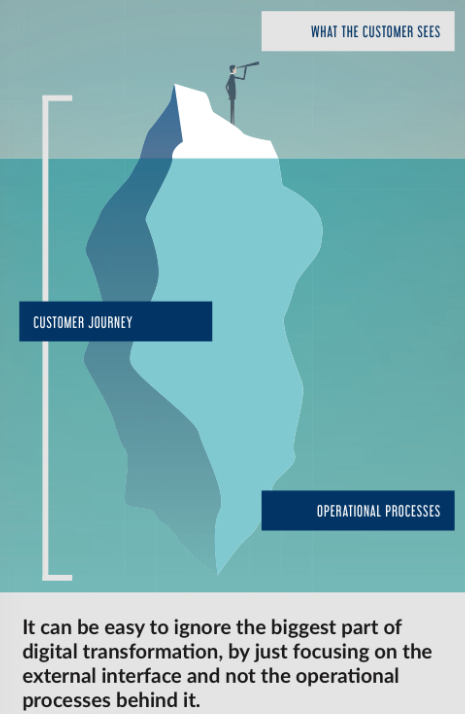How to digitise your processes and avoid common pitfalls

By Anna Milon, Senior Consultant, C5 Alliance
Digital transformation is the buzzword of the moment but has an all-encompassing meaning. One aspect of this which can have a significant impact is the digitisation of your processes. Digital Process Automation (DPA) is an evolution of Business Process Management (BPM). BPM has become associated with large and difficult-to-change ‘aircraft carrier’ style processes, which require bespoke coding and heavy developer involvement. This is at odds with the rapid software development and change strategies that companies are implementing now. DPA requires an agile, customer-focused approach and tools which support this, more like a team of speed boats to get you to your destination.
A lot of companies in Jersey, even in the finance industry, are just starting their digital transformation journey. This means that there probably isn’t a lot of tried-and-tested automation already in your organisation, but it also means there is an opportunity to get ahead of the pack.
DPA has the potential to drive enormous value across a business, with advantages such as:
- Audit control improvements – compliance and auditing is much easier in an automated environment.
- Time saving – By automating manual repetitive tasks in your organisation, you are able to save employees’ time and respond to customers more quickly.
- Cost reduction – When you automate processes, you also improve employee effectiveness which can contribute towards financial savings for your organisation.
- Better accuracy – DPA is able to achieve better accuracy in processes by eliminating situations where the documents may be misplaced, items mistyped or process steps missed.
- Adaptability – By implementing DPA, organisations are able to quickly launch and scale new solutions according to the needs of the market
- Improvements in customer experience – The accuracy and time-saving gained from automation can be passed on directly to customers as they receive more information, more quickly and accurately.
So where do you start? ?
Embrace the solution
It is important to obtain support that this is the right solution at all levels, with the right stakeholders, within an organisation.
Document your processes
Process discovery is a really important first step, because you get objectivity and direction and it will help you know the scope of the process you’re trying to digitise. This allows you to select and plan your initial automations with full knowledge and understanding of their scope.
Map the whole customer journey and cover as many processes as possible, because there could be some key crossover between processes that will provide huge benefits and efficiencies through process automation that you might otherwise miss.

A mistake that a lot of companies make is to jump in and create a cool app that customers can download, but leave a heavily manual process in the background. The company then doesn’t get the efficiency, audit and accuracy advantages of automation. If the journey is mapped at the outset, there is greater awareness of the scale and tasks of the full end-to-end process, which allows selection and planning of suitable automation possible.
Recruit the right people and consultant team
To effectively implement the solution you need the right combination of skills in house as well as the external expertise. Internal subject matter and process experts can be trained up to use the no-code solutions in combination with automation and DPA experts.
Identify the process you want to automate first
You don’t need to do everything at once! DPA is about quick wins and being agile and flexible. Pick a process which contains a lot of tasks relating to data management, such as any reliance on spreadsheets or batch processes, as these are the easiest to start automating. Once you’ve picked your process you can then identify which steps can be automated.
You don’t need to automate the whole end-to-end process; think about what will provide the most value to your team and customers, and which ones have the greatest potential for automation.
For example, updating a new customer’s information in your Customer Relationship Management (CRM) platform after they sign up as part of their customer onboarding process, or, for business development at events: Creating a workflow which adds leads to SharePoint and CRM and emails an attendee after you have added them via a form.
Focus on customer outcomes
Think about what can be automated that will make the customer’s life easier. Remember to focus on what will benefit your customers and how to make sure that the automations you set up won’t break due to fringe use cases. Start off simple and work your way up to larger processes. You don’t need to automate absolutely everything – everything you automate is one less task that you and your team has to manually tackle.
In your customer onboarding checklist you could set up fields to let you record all of the customer’s information. A combination of a process automation tool, such as Nintex, and a Robotic Process Automator, such as UiPath, can then detect when the task containing those fields is completed, scan for the information that’s been entered, and push that data into the corresponding fields in your CRM. Robotic Process Automation (RPA) can streamline business workflows by eliminating tedious manual tasks without requiring you to completely re-engineer legacy systems.
Select the right tools
At C5 we work closely with a number of partners to achieve successful outcomes, including Microsoft, Nintex and UiPath.
Measure outcomes
When you have measurable outcomes from your DPA, you can then prove its advantages to other decision makers and senior management. Original timings and requirements will have been documented in the discovery and documentation phase, so the improvements can then be shared and provide leverage for approval for further digitisation work. You don’t need to do all your processes at once!
Each win justifies the next investment.
Continuous improvement
One advantage of using a low or no-code process automation solution like Nintex is that you don’t need programming skills to make changes. This makes it is easy to make small tweaks and variations as you go along – creating a much more agile process, rather than the aircraft carrier equivalents of previous incarnations.
There’s no-one more familiar with the flaws of your processes than the people using them. Getting their opinion is important to keep the process iterative, get feedback and instil a culture of constant improvement to get the most success out of the automation.